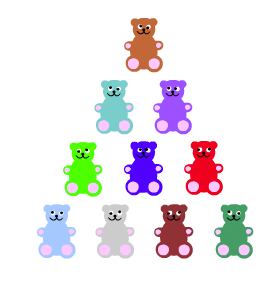Skip over navigation
Printable NRICH Roadshow resource.

Or search by topic
Number and algebra
Geometry and measure
Probability and statistics
Working mathematically
Advanced mathematics
For younger learners
Share Bears
Age 5 to 7
Challenge Level 





- Problem
- Getting Started
- Student Solutions
- Teachers' Resources
Share Bears
 Yasmin and Zach have some bears to share. Which numbers of bears can they share equally so that there are none left over?
Yasmin and Zach have some bears to share. Which numbers of bears can they share equally so that there are none left over?
Can they share one bear equally? Can they share two bears equally? Three bears? Four bears...?
What do you notice about the numbers they can share fairly? It might help to look at a number line and mark the numbers that do share fairly onto it. Do you notice a pattern?
How about using a 100 square?
Printable NRICH Roadshow resource.
Why do this problem?
This problem is an appealing way to help children understand the process of division as sharing. In particular, they will have the opportunity to investigate patterns when dividing by two and thus identify even numbers and hence multiples of two.
Possible approach
It would be great to have some real teddies or plastic bears for the children to physically share. Although there are ten teddies pictured in the problem, the exact number does not matter. Ideally, it would be good to have at least ten.
You could ask pairs of children to have a go at the problem, noting down on their mini-whiteboards (or shading a hundred square) which numbers of bears do share equally.
Bring the class back to talk about their findings. You could shade the numbers they have managed to share on a hundred square and then use this as a basis for discussing these special even numbers. Can the class predict what the next even number will be? How do they know? What is the largest even number on the hundred square? How do they know?
Bring the class back to talk about their findings. You could shade the numbers they have managed to share on a hundred square and then use this as a basis for discussing these special even numbers. Can the class predict what the next even number will be? How do they know? What is the largest even number on the hundred square? How do they know?
Key questions
How about starting with just one bear? Can you share this one bear fairly between both Yasmin and Zach?
Show me how you are deciding.
How do you know whether that number of teddies has been shared equally?
Show me how you are deciding.
How do you know whether that number of teddies has been shared equally?
How will you record which numbers do share fairly?
Possible extension
Children could investigate sharing the bears between more children and recording their findings on a hundred square in a similar way.
Possible support
Pairs of children could physically share the bears/counters between themselves - this makes the problem more accessible.
You may also like
Biscuit Decorations
Andrew decorated 20 biscuits to take to a party. He lined them up and put icing on every second biscuit and different decorations on other biscuits. How many biscuits weren't decorated?

